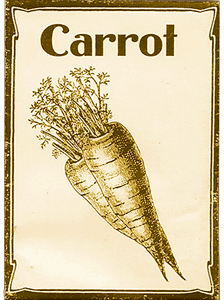CARROT
Vitals
• Daucus carota, belonging to the carrot family, Apiaceae/Umbelliferae .
• Origin: Central Asia, from Afghanistan to the Caucasus.
• Early archeological evidence: Leaves and seeds in Babylon, 800 BC.
• Early literary reference: In the second century AD, the Greek physician Galen described a common confusion between carrots and parsnips.
• Early cultivation: Uncertain, as root crops are highly perishable and unlikely to be preserved. The best guess is around 1000 BC in the Fertile Crescent (between the Nile and Indus rivers).
• Climate: Sunny and cool (40–80 °F; 4–27 °C).
• Major producing countries: China, United States, Russia.
Short history“What’s up, doc?” asks Bugs Bunny as he chomps a carrot, greens and all. These tasty roots, packed with vitamins, weren’t always the sweet treats that Bugs enjoys. Carrots began as weeds with woody red roots. Cultivated carrots in tenth-century Iran and Arabia were both yellow and purple. Despite efforts by Asians, Greeks, French, and others, a sweet, appealing carrot didn’t appear until the sixteenth century in Holland. Carrots didn’t become popular in the United States until World War I, when travelers to Europe discovered them and brought them home.
Carrot facts and loreCarrot juice was one of the first substances used to color pale European cheeses.
Because of their sweetness, carrots were used in cakes and puddings before sugar was widely available.
In seventeenth- and eighteenth-century Holland, carrots were grown mainly to feed Holstein cows. These cattle were known for producing rich butter tinted yellow by the carrots.
Wild carrot (Queen Anne’s Lace) that dots country hillsides today is actually an escapee from the garden of England's King James in the early 1600s.
Saving the seedCarrots flower only every other year, so you’ll need to winter some of your carrots and replant them the next year if you live in a place where temperatures might damage plant roots.
• Harvest carrots when the roots are ready to eat.
• Select carrots that look to have the most desirable traits. Finger-sized roots will winter better than fully grown carrots.
• Clip the tops to one to two inches, and store at 35–40 °F (2–4 °C) in a humid location, layered in sawdust or sand. And don’t forget that you can eat the carrot tops!
• Replant the roots in spring, about 3 feet (1 meter) apart. If you have other carrot varieties in your garden, make sure they are separated by at least 250 feet to avoid cross-pollination.
• Carrots will flower after they have experienced autumn-like temperatures for several weeks. When the flower clusters, called umbels, begin to dry, pick them.
• Clean the chaff from the seed by rubbing the clusters between your hands and then winnowing them (sifting the material from one container to another outside in the wind).
• Carrots are particularly sensitive to inbreeding, so save seed from as many separate carrots as possible.
Saving and planting seeds is easy. Make sure that the plants you are saving seed from are what’s called an “open-pollinating” rather than a hybrid variety. For a list of companies that sell seeds for open-pollinating plants, see this our article Why Save Seeds?
